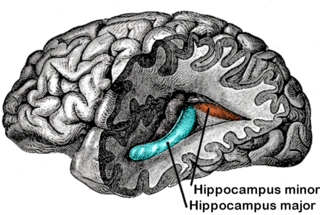Depression
3 Secrets for Preventing and Treating Depression
The hippocampus holds the key.
Posted December 27, 2019 Reviewed by Gary Drevitch
For decades, the standard of care for treating depression — and its close cousin, anxiety — has been psychotherapy and anti-depressants.
When medication fails (anti-depressants perform only slightly better than placebos, on average) and talk therapy doesn’t improve mood (recent literature reviews suggest that the efficacy of psychotherapy has been overestimated), the next line of treatment includes transcranial magnetic stimulation, electroconvulsive shock, and more recently, administration of ketamine.
All of the first-line and second-line treatments for depression, in addition to having less-than-perfect efficacy, and frequently negative side effects, can be expensive and time-consuming.

But new research on a part of the limbic system called the hippocampus suggests three approaches to treating depression that are inexpensive, relatively quick-acting, and free of side effects. Two of these methods make the hippocampus more active; a third makes certain parts of the hippocampus less active.
Three secrets
The first two secrets emerge from anatomical studies of depressed patients that show atrophy (up to 20% of volume) of hippocampus in severely depressed patients. This hippocampal atrophy may explain cognitive and memory deficits in depressed patients because the hippocampus is known to be heavily involved in memory and learning, especially spatial learning.
Recent research indicates that the hippocampus also plays a direct role in maintaining mood. Although there are tantalizing hints about the hippocampal-mood connection (more about that later), exactly what this role is remains unclear.
What is becoming clear, however, is that hippocampal atrophy can be slowed, halted, and even reversed through two simple, inexpensive, side-effect-free techniques.
Physical Exercise. Psychotherapists often prescribe aerobic exercise to depressed and anxious patients as a stress reliever, but the lasting benefits to mood of exercise may be due, at least in part, to the positive effect that physical exercise has on hippocampal volume. In a 2018 comprehensive meta-analysis of research on the exercise-hippocampal link, Firth et al, of the University of Western Sydney in Australia found that, in animals, exercise could increase hippocampal volume, and in humans, slow or prevent further atrophy.
And Ericson et al, writing in a 2011 edition of the Proceedings of the National Academy of Science, have demonstrated increases in volume of anterior hippocampus in adult humans after prolonged aerobic exercise.
Whether the benefits of physical exercise result from lowered levels of hippocampal-toxic stress hormones (e.g. cortisol), improved blood flow to the hippocampus, or trophic effects of increased neuronal activity in hippocampus during exercise aren't yet clear. What is known is that a sustained program of exercise is good for both your hippocampus and your mood (not to mention cognition and memory).
Demanding mental activity. The hippocampus has been shown to have remarkable plasticity, even including growth of new neurons in adult brains. A study of London cab drivers, for instance, showed consistent increases in hippocampal volume in drivers who were compelled to learn “the knowledge" about every street in the vast metropolis of London.
These findings don’t mean that you have to memorize a street map of London to grow your hippocampus, but they do suggest that engaging in challenging new cognitive tasks that require the formation of new memories—especially spatial memories—can foster a healthier hippocampus. Spatial puzzles, mazes, even driving to new locations and intentionally getting lost might do the trick. Jogging through mazes or unfamiliar streets to get exercise while forming new memories could be doubly beneficial.
Decrease re-activation of negative memories. The third way to enlist the hippocampus in the fight against depression, paradoxically, isn't to increase hippocampal activity, but to selectively decrease it.
Zhang et al. of McGill University, writing in the November 2019 Journal of Neuroscience, found that, in animals, negative memories encoded in the hippocampus as “negative engrams” are highly correlated with depressive behaviors such as social avoidance. The McGill researchers created these “negative engrams” by subjugating mice to “social defeat” (basically being lowest animal in the social pecking order), then used sophisticated neuronal labeling techniques to identify specific neurons in the hippocampus that encoded memories of social defeat. When the researchers artificially stimulated this subset of “negative engram” hippocampal neurons, “socially defeated” animals increased social avoidance and other depression-like symptoms.
Zhang and colleagues speculate that, in humans, frequent re-activation of negative memories (e.g. obsessively reliving traumatic events) encoded in the hippocampus could play a key role in fostering and sustaining depression.
In addition to establishing a potentially causal link between hippocampal activity and depression, a clear implication of this finding is that shifting from re-activation of negative memories encoded in the hippocampus to re-activation of positive memories would elevate mood.
This last conclusion might seem trivial and obvious to healthy people: If you want to relieve depression, of course don’t dwell on the negative. But for patients trapped in a vicious cycle of negative ideation—helplessness, hopelessness and more negative feelings about that hopelessness and helplessness—it's far from obvious.
Thus, psychotherapists, friends, and family, while not invalidating the negative memories and emotions of a depressed person, might help alleviate symptoms of depression by helping afflicted individuals focus on happy memories and thoughts instead of perseverating on negative ones.
That's far easier said than done, I know. But the latest research on the hippocampal-mood link suggests that, one way or another, switching from re-activation of negative memories to positive ones could be an essential technique in restoring the hippocampus, and its owner, to full health.
References
https://www.ncbi.nlm.nih.gov/pmc/articles/PMC3041121/
https://www.ncbi.nlm.nih.gov/pmc/articles/PMC18253/
https://www.ncbi.nlm.nih.gov/pmc/articles/PMC60045/
https://www.jneurosci.org/content/39/38/7576
https://www.sciencedirect.com/science/article/pii/S1053811917309138
https://www.ncbi.nlm.nih.gov/pmc/articles/PMC2440814/
https://www.cell.com/cell/pdf/S0092-8674(18)31313-8.pdf




